A ham is actually the rear leg of the pig, from shank to rump, that has been cured, sometimes smoked and sometimes fully cooked. There are three different preparations of ham that you can buy. The first and most common ham is called a city ham. It is wet-brined, usually smoked and fully cooked when you buy it. It can be eaten just as is, or baked and re-heated properly so that it retains its moisture. The recipe below is for a city ham, which is what most people are probably used to cooking.
The second type of ham you might find, especially if you live in Virginia, Tennessee or anywhere in Appalachia, is called a country ham. A country ham is dry-rubbed with salt and spices and hung to air-cure for months. It may or may not be smoked and it is usually uncooked. The flavor is concentrated and salty and it is not naturally moist. Cooking a country ham takes more attention than cooking a city ham. You need to soak the ham for a day and then simmer it in water to reduce the salty flavor before baking it.
The final type of ham is a fresh ham (although this is much less common in most grocery stores). A fresh ham is raw and uncured. It is basically the rear leg of the pig. You could cook it the same way you might cook a pork shoulder (probably braise it) or you could cure it yourself at home and then cook it.
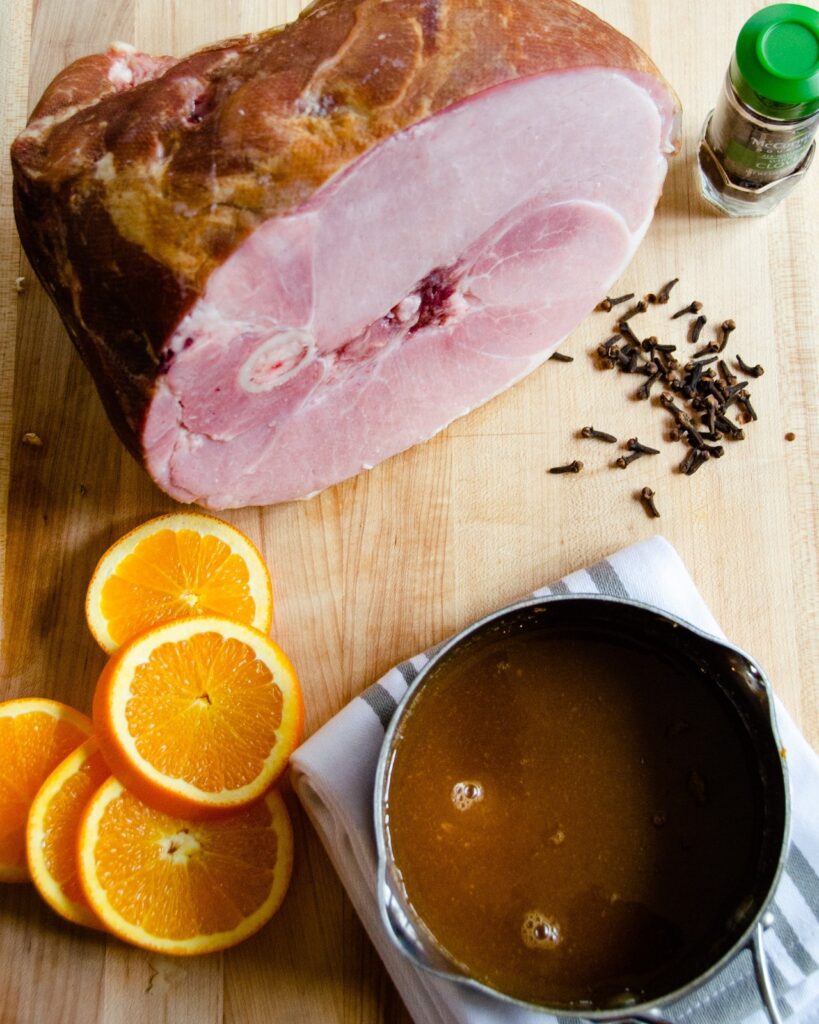
A whole ham is a significant piece of meat so unless you’re feeding a huge crowd, you’ll probably want to buy half a ham. Bone-in hams are cut into the butt end and the shank end and these two ends do differ slightly. The shank end of the ham has more fat (and consequently more flavor) and is easier to slice because it had one straight bone in it. The butt end of the ham is leaner and more difficult to carve because of the aitchbone (pelvic bone). Boneless hams have had the bone removed and then the meat is forced into an oval shape. The muscle does rejoin and appears to be a single piece of meat when cooked. I’ve always preferred a bone-in ham because it retains moisture well, tastes fantastic, PLUS you’re left with a ham bone which is such a fantastic ingredient for making my favorite soup – split pea. Spiral-cut hams make slicing much easier, but they are more prone to drying out so you’ll need to cover the ham with aluminum foil when baking it before removing the foil to glaze the ham for the final stage of baking.
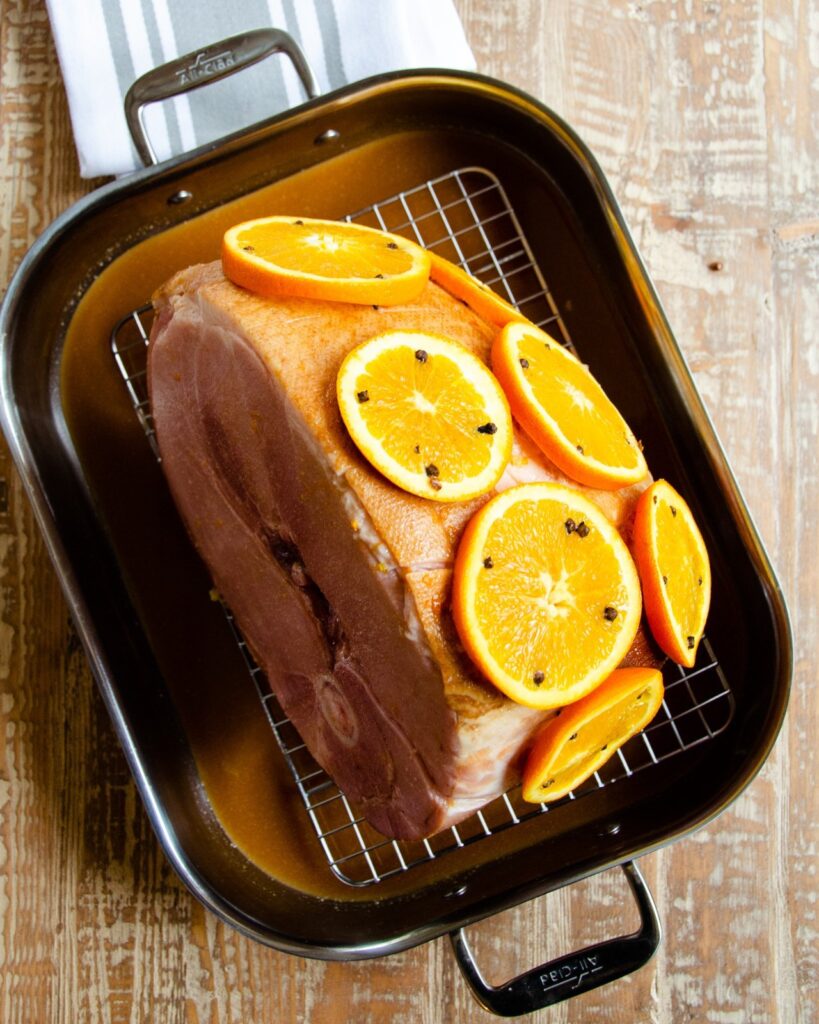
Finally, take a look at the label when you’re buying a ham. It’s likely that you’ll see a description that includes water. Hams that are wet-cured (brined) will sometimes have that brine injected into them. If the label says “Ham with natural juices” it probably has about 7 – 8% added water weight and this is the liquid that naturally comes out of the ham in the curing process. A ham that reads “Ham, water added” could have as much as 10% added water weight. Finally, “Ham and water product” could have any amount of water added to it, increasing its weight and consequently its price, but not its flavor. Your best bet is to find a ham that has only natural juices.
The label will also tell you whether or not the ham has been smoked. If it says “hickory-smoked” you can be sure it was smoked in a smokehouse. If it says “hickory smoke” in the ingredient list, that just means that liquid smoke flavor has been added to the brine.
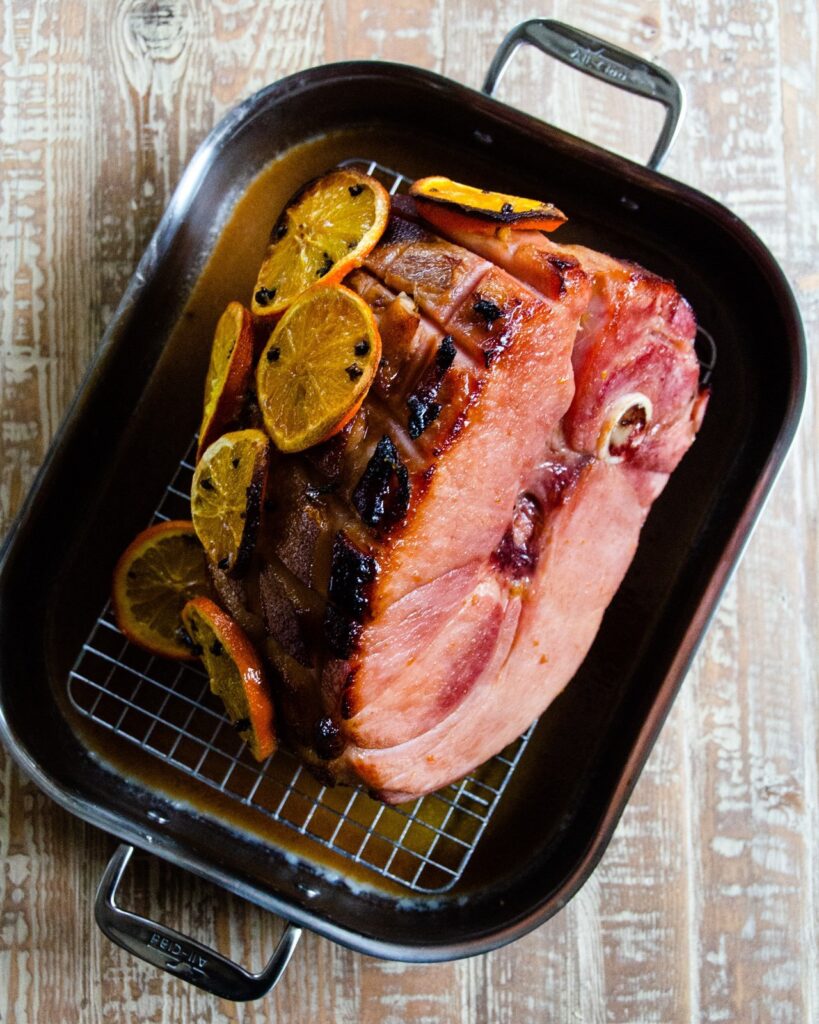
That’s a lot of information… see, that’s the hardest part. Once you’ve bought your bone-in (shank end or butt end), cured, smoked, city ham with natural juices, cooking it is easy. This recipe and video shows you how to score the fat on top of the ham (this helps render some of the fat and helps to crisp it up) and season it with cloves and orange slices (although you could use pineapple, apricots, apple, or other fruit). This recipe also includes a glaze that you can baste on the ham and reduce at the end to form a jus for the table. It’s so easy if you have a couple hours to let the ham heat up properly. You’ll just need a good roasting pan and rack, a bulb baster and a good basting brush to make the job really simple. If you do decide to cook a spiral-cut ham, cover the ham and pan with foil and increase the time to 15 minutes per pound. Then, uncover it and glaze it in the oven for 20 minutes at the end. Serve it with a delicious potato gratin and a green vegetable and some of the cooking jus at the table to moisten your already moist ham.
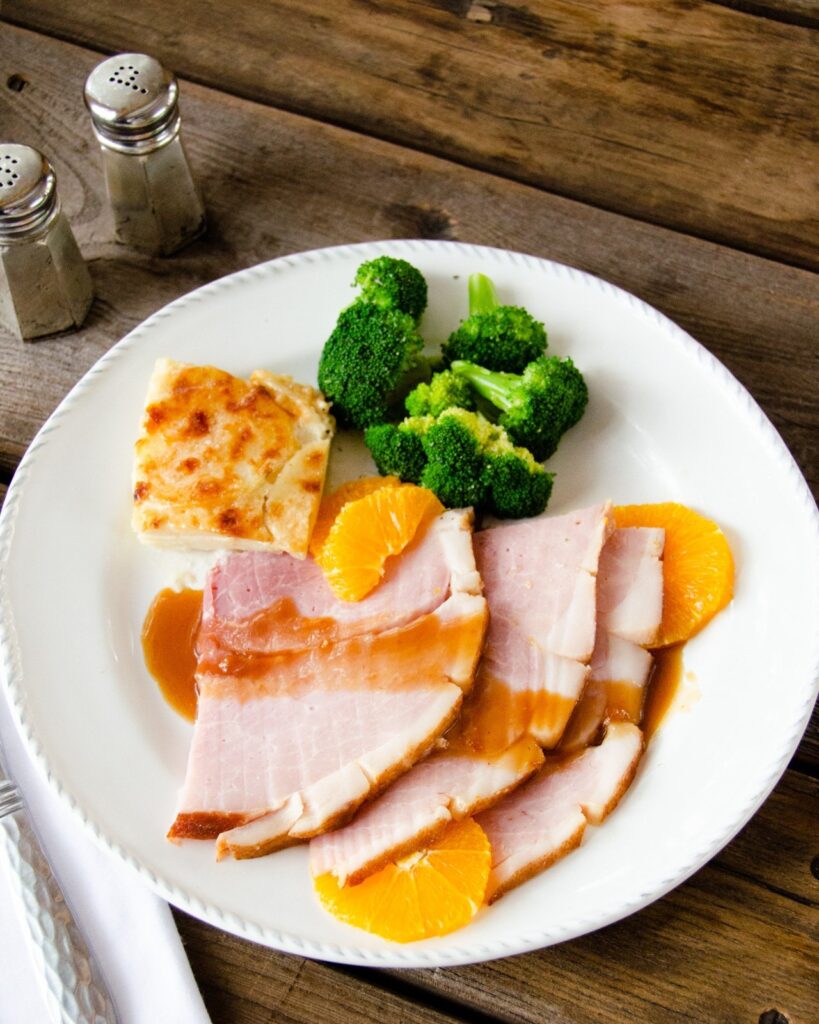
Don’t save this delicious dinner for just one meal of the year. Surprise folks with it some Sunday afternoon when you have to time to sit back and watch it cook perfectly in your oven. It’s so easy you might just surprise yourself!
If you don’t have time to bake a ham in the oven, you can always make a deliciously moist ham in a pressure cooker (see recipe below) and glaze it under the broiler at the end. That’s a sure fire way to get a super moist ham in just half an hour.
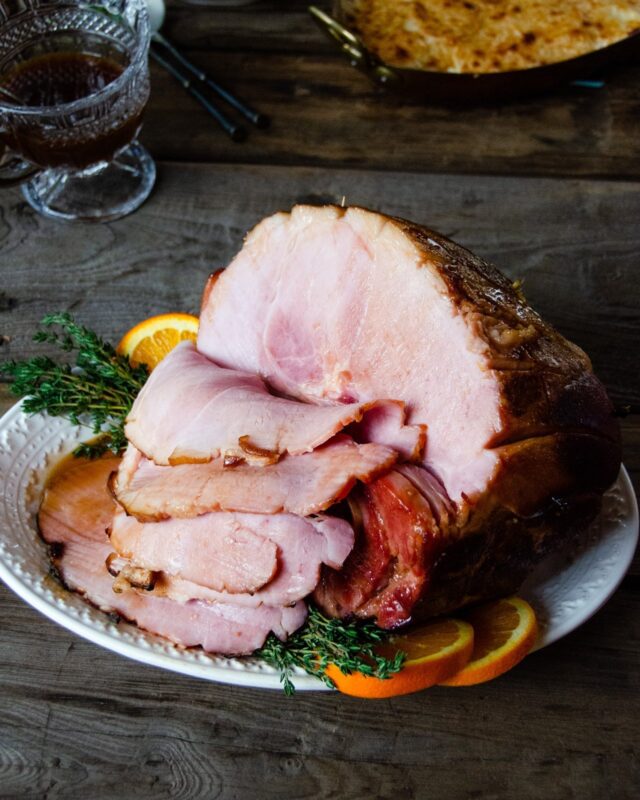
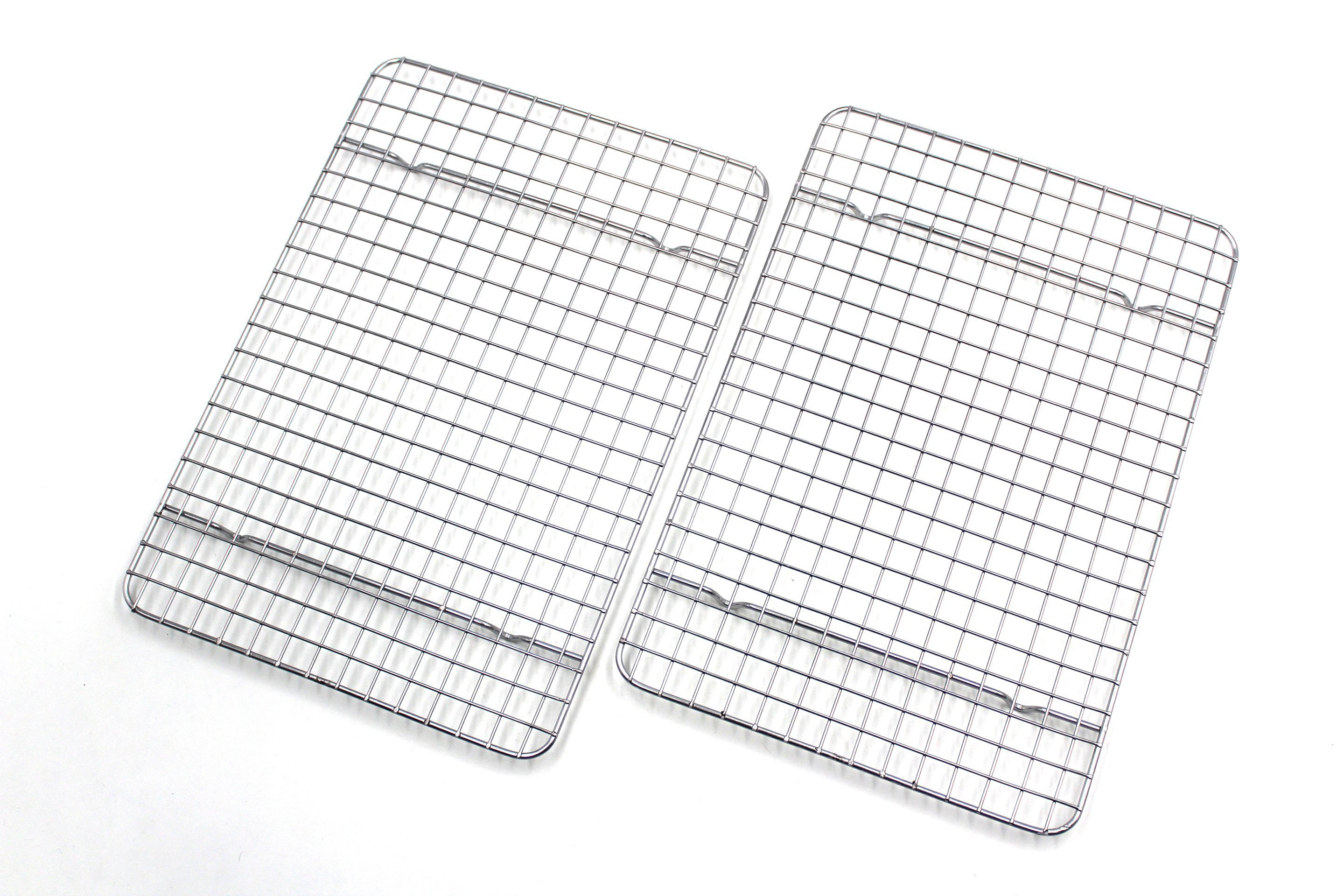
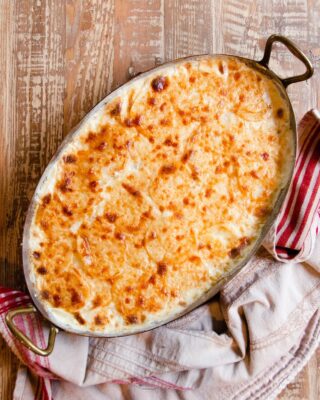
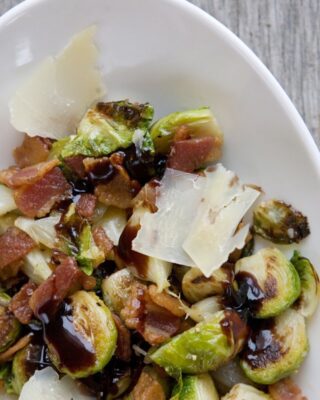
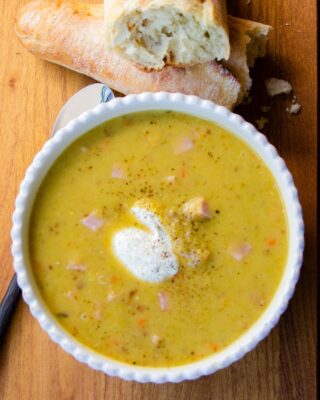
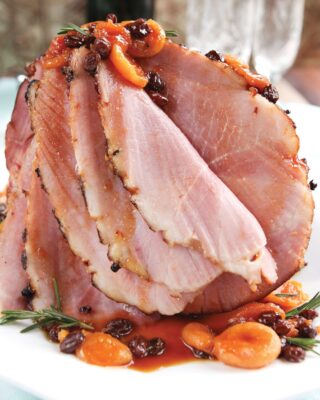
Looking forward to making this ham! You always have the best recipes!! Could this be done in an air fryer?
You could roast a ham in the air fryer, but I prefer the results out of a pressure cooker. You get a more moist ham that way.
Do you cover the ham with foil before putting it in the oven? What keeps it from drying out?
Hi Jane. No, I don’t cover the ham with foil. The liquid in the bottom of the pan and the regular basting keeps it moist.
Would it be 30 min in instant pot on high pressure, then natural release? Thankyou for mentioning to stay with the sauce. Great hint, What a sticky mess like you said if it boils over. It’s those little hints you give that make me such a fan. Can’t wait to try this, and enjoy the leftovers.
Hi Dee. Yes – about 25 – 30 minutes on high pressure and then natural release. You can follow this recipe as a guide.
Thank you Meredith for your lovely reflection and encouragement to celebrate and rejoice for those of us still here and remembering the many who are not.
We have made your instapot Ham and Madiera with apricots several times before the pandemic for friends and during the past year for the 2 of us. Always delicious and the ham so moist. We are ordering frenched rack of lamb or loin lamb chops for Easter. Thinking either your Brussels sprouts recipe or asparagus vegetable couscous with feta. It will depend what our Insta cart shopper finds. One of the many things we have learned during these last 12 months, patience and flexibility! Happy Spring, Happy Passover, Happy Easter to your family and fur babies! Stay safe and well🙏🍷
This looks a tasty recipe.
Is it included in one of your cookbooks? And if so, which one?
Many thanks,
Hi Janet, no this recipe is not in my cookbooks. This one was developed just for the website.
Can this be made with a 10 lb fresh ham?
Hi Brenda. Not without adjusting it.This recipe is for a city or country ham. You can read about the differences between these hams on my lesson on ham here: https://bluejeanchef.com/cooking-school/all-about-ham/ A country ham will take 18 – 20 minutes per pound. This recipe is thoroughly re-heating a cured ham and only allows for 10 – 12 minutes per pound. You could use the same glaze for your ham as is in this recipe. Just keep your eyes on it to make sure it doesn’t evaporate through the extended cooking time. You can add a little stock or more juice if it does start to evaporate.
Trying to figure out which Madeira wine to use. I see there are 4 types and all flavored differently. I want to make sure I get the correct one.
You’ll want to use a Madeira wine on the drier side which is less sweet. The drier types are sercial and verdelho. You can also use a blended Madeira. A little sweetness is nice with the oranges but you don’t want it to be too sweet.
Made this ham for Easter!it was fantastic! Will be my go to recipe for sure!